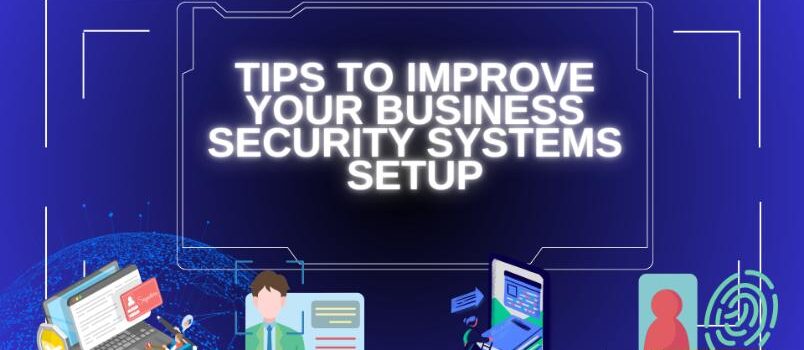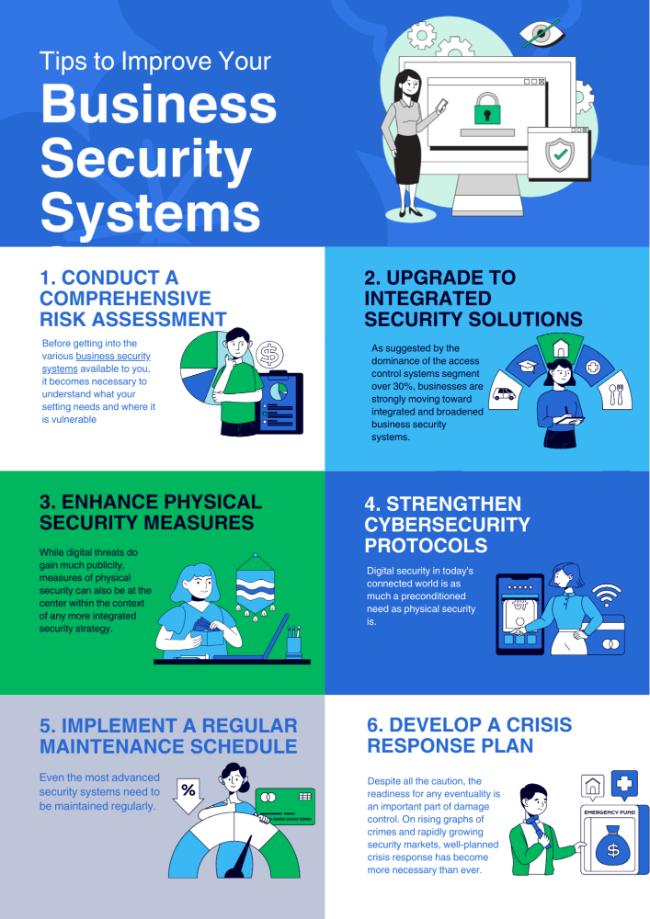Safety and security in this age of speeding business and the corporate world take precedence over all other things. The reason behind it is obvious. The projected growth of the commercial security system market to $343.7 billion by 2028 underscores the importance of having robust security measures in place. Every business, no matter the size, needs some form of security system in place. Here are some key tips to use to boost one’s current business security setup and always be one step ahead of the bad guys.
1. Conduct a Comprehensive Risk Assessment
Before getting into the various business security systems available to you, it becomes necessary to understand what your setting needs and where it is vulnerable. A proper risk assessment helps identify weak points and prioritize security efforts.
- Analyze vulnerabilities: You should be able to find holes in your security in both physical and digital gaps of the current setup. This comprises entry points, network vulnerabilities, and any insider threats.
- Prioritize Threats: Focus especially on high-risk areas, those that would cause the most damage in case of a breach. This is especially true for places that hold very valuable assets, where sensitive data is stored, or places where critical operations are run.
- Plan for Contingencies: Design plans against internal and external threats. This approach will keep you on your toes concerning many security breaches.
“Understanding your risks is the first step towards building a robust security system,” says John Doe, a renowned security expert.
2. Upgrade to Integrated Security Solutions
As suggested by the dominance of the access control systems segment over 30%, businesses are strongly moving toward integrated and broadened business security systems.
- Unified Systems: Combine surveillance, access control, and alarm systems for easier management. It enhances coordination and thus enables prompt responses.
- Real-time Monitoring: Install technologies that will alert you in real time and allow remote access. This keeps you updated on your security status 24/7, even when you are perhaps not at the site.
- Smart Analytics: AI and machine learning detect anomalous activities and predict threats. These technologies are at a very high level and can make any security team very productive.
Comparison Table: Traditional vs. Integrated Security Systems
Feature |
Traditional Systems |
Integrated Systems |
|---|---|---|
Management |
Separate systems |
Unified platform |
Monitoring |
Often manual |
Real-time, automated |
|
Analytics |
Basic |
AI-powered, predictive |
| Scalability | Limited | Highly scalable |
| Response Time | Slower | Faster, coordinated |
| Cost Efficiency | Higher long-term costs | More cost-effective |
3. Enhance Physical Security Measures
While digital threats do gain much publicity, measures of physical security can also be at the center within the context of any more integrated security strategy.
- Access control: For keyless entry, the Biometric systems shall be fitted to avoid undue access to premises. These modern solutions offer better security and easier management compared to traditional lock-and-key systems.
- Security Cameras: Install high-definition cameras at these critical points, which would cover the time 24 hours a day. Since video surveillance would be the prime component of the whole commercial security system, one should invest in some fine-quality cameras.
- Environmental Design: This technique, probably best suited for improving an organization’s physical security, would use barriers, lighting, and landscaping in a way to deter intruders or improve visibility.
4. Strengthen Cybersecurity Protocols
Digital security in today’s connected world is as much a preconditioned need as physical security is. With the increasing adoption of AI and ML for advanced threat detection by most businesses, staying ahead in cybersecurity measures has become foremost.
- Network Segmentation: This involves isolating sensitive data in a protected network to contain potential damage in the event of a breach. This would go a long way in possibly compartmentalizing potential security incidents and protecting your highest-value assets.
- Update Regularly: Always update both software and hardware with newly available security patches. Known system weaknesses that continuously plague obsolete systems are taken advantage of by cybercriminals.
- Employee Training: Implement regular programs on cybersecurity awareness to preclude human errors. Your employees, regarding potential cyber-attackers, are the first line of defense in most instances.
5. Implement a Regular Maintenance Schedule
Even the most advanced security systems need to be maintained regularly. The commercial security system market is expected to grow and surpass $354.16 billion by 2030. Informed always makes information about the lifecycle status and the device’s operating condition accessible to users.
- Routine Inspection: Test all your security equipment to ensure it is functional, and repair it as needed. Good maintenance of your equipment will avoid unexpected failures in critical moments.
- Software Audits: This will include periodic scanning of security software for any vulnerability and maintaining industry standards. By this, you stay ahead of newly emerging threats and regulatory requirements.
- Upgrades: Enable periodic updating to ensure that your security systems remain current as the threats continue to evolve. After all, technology is very dynamic, and so must your security.
6. Develop a Crisis Response Plan
Despite all the caution, the readiness for any eventuality is an important part of damage control. On rising graphs of crimes and rapidly growing security markets, well-planned crisis response has become more necessary than ever.
- Emergency Protocols: Define procedures to follow in the event of different types of security breaches. This will facilitate prompt and coordinated action at a time when every second counts.
- Communication Channels: For this reason, establish proper lines of communication with your internal and external stakeholders. Communication is very vital in times of crisis.
- Drills and Simulations: It provides preparedness and rapid response through regular exercises. Rehearsals under situations related to the demanding ones’ perfect performances.
Conclusion
Setting up business security systems is a continuous process: properly planned, implemented, and maintained. With the aid of the above tips and keeping yourself abreast of the latest trends and technologies in security, you will be able to increase your business’s safety and resilience substantially against a host of threats.
Remember that an effective security system must be tailored to your needs and regularly updated to address new challenges. From the cameras down to live video monitoring and cyber-security measures, the magic lies in coming up with an integrated system that reaches every nook and cranny of your business.
FAQs
-
How often should I update my business security systems?
In my experience, quarterly reviews are nice to maintain pace for updates; while major overhauls would take place every 2-3 years at best, based on technology shifts and a person’s risk profile.
-
What are the key features to look for in an integrated security system?
Key features include real-time monitoring, scalability, AI-driven analytics, and integration with existing systems. It would also be very relevant to have remote access and instant alerts.
-
How can I ensure my employees comply with cybersecurity protocols?
This will go hand in glove with strict access controls and running regular training sessions by simulating phishing attacks to ensure a culture of security awareness and, hence a culture of good cybersecurity practices.
-
Are wireless cameras as reliable as wired ones for business security?
Even with improved flexibility at installation, digital wireless cameras do offer excellent reliability and might raise other issues with more frequent maintenance and interference. Thus, what is best for your business depends on your particular needs and environment.
-
What’s the difference between live video monitoring and standard video surveillance?
Live video monitoring involves the real-time observation of security personnel so that on-the-spot action may be taken in response to an incident. Standard video surveillance usually has the feeds recorded for later review. Live monitoring is much more proactive in terms of security, although usually more expensive.
-
How can small businesses implement effective security measures on a budget?
Begin by performing a proper risk assessment, and then there will be an idea of what needs priority. Scalability in cloud security solutions offers flexibility. Some basic measures would include good lighting, quality locks, and employee training. Improve by degrees as the budget allows.



